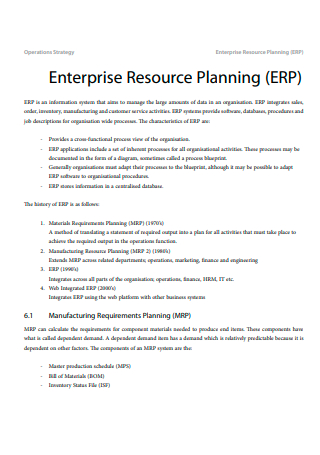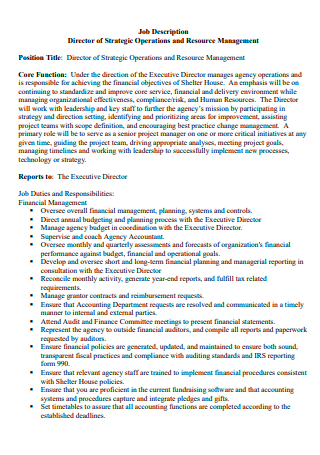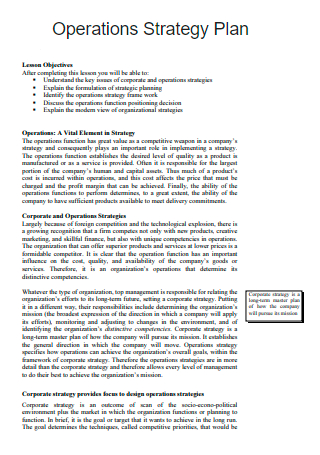4+ Sample Operations Strategy Plan
FREE Operations Strategy Plan s to Download
4+ Sample Operations Strategy Plan
What Is an Operations Strategy Plan?
What Is the Importance of Operations Strategy Plan?
What Are the Types of Operational Strategy Plan?
What Are the Components of Operations Strategy Plan?
How Do You Write Operations Strategy Plan?
FAQs
What Makes a Good Operation Strategy Plan?
What Are 4 Purposes of Operation Strategy Goals?
What Is an Important Tip to Remember for an Operation Strategy Plan?
What Is an Operations Strategy Plan?
Operational Strategy Plan is a company-wide strategic plan used to map out and strategically plan future-orientated goals in relation to all organizational departments from finance, human resources to sales and marketing. Operational planning refers to the creation of an outline of what activities a department or organization will focus on in the coming months. An operational plan is the “how” to any organization’s long-term vision. It lays out how a department will accomplish a specific project that is part of a larger effort in the company’s vision. A strategic plan sets big, grand goals for a vision, with major tasks you must complete over time to get there, while an operational plan serves as the blueprint for how a department will complete each task. When implemented successfully, operational strategies strengthen a company’s overall strategy and may help achieve marketplace advantage over competitors. An effective business strategy considers a company’s long-term objectives and creates steps that cohesively bond business plans with resources, capacity, time, location, and competition. It can also improve an organization’s competencies and infrastructure, allowing it to better serve customers and keep or even extend its competitive advantage over others in the market.
What Is the Importance of Operations Strategy Plan?
Companies or organizations that do not take the time on operational and project planning are often winging it, which means they run into obstacles along the way and are unsuccessful in achieving overarching goals. Here are three main importance in doing this planning correctly:
It boosts productivity. Everyone is more productive when they have proper guidance on what they should be doing. An operational plan provides that direction to your team. They will know what is expected of them and understand the deliverables. They’ll just flat out be more motivated to do the work when they understand and believe in the vision.
It makes success more likely. Setting ambitious goals is essential as an organization, as it gives you something to drive toward. But you won’t realize those goals without a practical, realistic plan. Drafting an operational plan makes it more likely the organization will succeed.
It improves teamwork and collaboration. With an operational plan in place, everyone has a role and teammates are not stepping on each other’s toes. The plan lays out who is responsible for what and sets expectations on how and when these tasks are achieved.
What Are the Types of Operational Strategy Plan?
You will probably use two types of operational plans: single-use and standing, hence, there are more to learn:
A single-use plan is an operational plan relates to a particular project, and it is discarded once the project is complete. Use this when the project doesn’t match another project or is not likely to be used again later. You can customize it to fit the individual project. On the other hand, a standing plan is an operational plan that is used repeatedly. A department will use this for projects or tasks that crop up frequently. Having these plans in place means you won’t have to “reinvent the wheel” each time, but you will sacrifice some flexibility.
What Are the Components of Operations Strategy Plan?
Regardless of business type, operational plans are non-negotiable. These should occur at least once per year, although some operations may repeat this exercise frequently over the farm season.
Whatever operation needs a solid plan, there are five major components to focus on: Preparation, marketing, logistics, human resources, and financial limits.
Preparation
After a well-earned break from your busy season, it is time to look at the year ahead. As always, purposeful preparations will position you and your farm to be in a better spot to capitalize on potential success. Failure to plan and adequately prepare may leave you short-handed or in a situation where you have limited options due to a lack of preparation. For many operations, this might mean checking on equipment and making necessary preparations. You may be doing this yourself or leveraging the capabilities of your employees or an external resource. Or, if an operator is inexperienced using a piece of machinery, this could also become part of your preparation. Especially true with hired labor and the cost of time if they are not properly prepared.
Grain and Livestock Marketing
While opinions vary on the authoritative information source for commodity markets, there are many valuable resources available. Consider how the following can help you capitalize on opportunities to keep your business financially healthy.
Logistics
Logistics is where the work is accomplished and carried out daily. Planning is necessary to have strong logistical outcomes and closely connects with the implementation of your production plans. These can be as simple as maintaining a clean yard site or ensuring delivery is on time to keep everything in each day or week running smooth.
Human Resources
Employees will have a greater sense of purpose and ownership for tasks when their roles are clearly defined and correspond to responsibilities at the farm. Equally important is being clear about procedures and protocols around performance reviews, standard check-ins, health and safety and disciplinary measures. Having a thorough HR strategy also covers any farm owner’s blind spots. Consider enlisting an external HR advisor to review your plan and identify any gaps. This is especially valuable if your business has shifted focus from one area to another or expanded its operational scope.
Financial Limits
Whatever plan you have, it must be carefully penciled out to make financial sense. FCC mortgage, equipment loan, and lease calculators give you a quick and accurate understanding of future purchases and how they may look over a set amount of time through a qualified budget. You can also open up your plans with your external partners or your lender.
How Do You Write Operations Strategy Plan?
Step 1: Examine Your Organization’s Vision
Any organizational project is a steppingstone to achieve a larger vision, so know and understand that vision before initiating any project. Talk to leadership and find out what they consider important. Then think about how your project fits into that bigger picture.
Step 2: Define the Goals and Strategy
Now that you understand where your tasks fit into the big picture, figure out what the goals of this specific project should be. Then draft a strategy on how you will get there as a department. At this point in the operational planning process, draft a scope of work, and identify stakeholders.
Step 3: Plan Out Activities
With vision, goals, operations strategy, and project scope handled, now you can get into actually planning the activities. You must be very specific, laying out what concrete plans to reach the end goal. Break these into small steps. Start with the goal, and then determine what the preceding step would look like. Each larger step could have subsets to further break them up. You must list all supplies, equipment, training, and other resources you will need to accomplish each task. Without these, you will fall behind.
Step 4: Assign Roles and Responsibilities
Assign roles and responsibilities to team members. Select and assign people to tasks based on their skills. Lay out communications strategies so you are all on the same page. Be specific about team member reporting structures and deadlines you expect them to meet. Consult with each member of your team: After you draw up the plan and assign responsibilities, meet with members of your team individually for a gut check. Reward successes: Motivate your team by offering them rewards if they meet critical milestones: maybe a bonus or a pay raise, or something more modest, such as a gift card.
Step 5: Monitor and Adjust
Monitor progress and adjust as necessary to ensure everything is on track. Hold your team to the deadlines you set, and if you miss a deadline, adjust the plan to keep from getting off track. Draft work reports throughout the project so you can properly analyze team performance. A rigid project is doomed to failure, so bake in room for adjustments. Be willing to drop some less-important goals for more important ones, and be prepared to shuffle people into different roles at a moment’s notice. Have a post-project meeting: When you have finished with the project, meet with your team to talk over what went right and what could be improved. Keep a positive outlook and encourage honesty so you can identify opportunities to execute the next project even better.
FAQs
What Makes a Good Operation Strategy Plan?
Your operational plan will be a useful document for your investors. The best operational plans have a clearly articulated objective that everyone in the company is focused on achieving. However, it can also help you and your employees by encouraging you to think carefully about deadlines and tactics.
What Are 4 Purposes of Operation Strategy Goals?
There are many advantages to establishing organizational goals: They guide employee efforts, justify a company’s activities and existence, define performance standards, provide constraints for pursuing unnecessary goals, and function as behavioral incentives.
What Is an Important Tip to Remember for an Operation Strategy Plan?
Use a mission statement as a guide. Before creating your operation strategy plan, it is important to have an encompassing mission statement that defines the organization’s core objectives. This means you may have a broad mission statement that creates a clear business approach and articulates plans for achieving it.
No matter what operation strategy plan you are using and performing, the multiple adjustments will always remain. Producers must continue to rethink the boundaries of their plans, especially considering timelines, farm location, market vagaries and unseen opportunities or threats that may arise.
In a world that shifts quickly, having a backup plan is a prerequisite. Having a backup to your backup is a good idea, too. The bottom line is that an operational plan is not rocket science, but you have got to put in the work. A good operation strategy plan will be mapped out in great detail, spelling out manpower, resources and specific steps you must take. This is not something you can whip up in a half hour on your lunch break. Set aside hours or even days to do the legwork, meet with stakeholders and leadership, and draw up a strategy, with detailed action steps. If an operation strategy plan exists but has been static for more than one marketing year, it is a good practice to spend half a day or a full day reviewing it.





